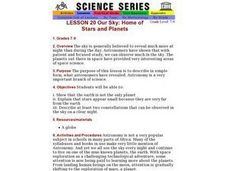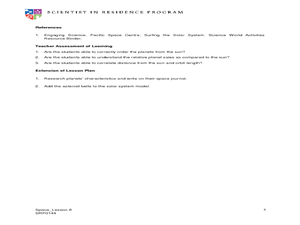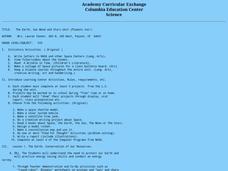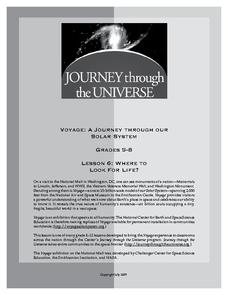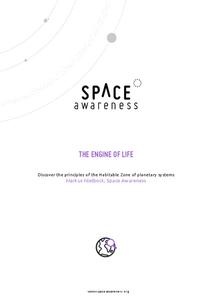University of Colorado
Looking Inside Planets
All of the gas giant's atmospheres consist of hydrogen and helium, the same gases that make up all stars. The third in a series of 22, the activity challenges pupils to make scale models of the interiors of planets in order to...
Curated OER
Twinkle, Twinkle, Little Star
Students identify patterns in the stars. In this constellation lesson, students simulate constellations using black canisters and patterns. Students discuss the points on the constellations and how to draw imaginary lines to see the...
Curated OER
Our Intriguing Star, the Sun!
Explore the sun in a lesson plan about space. The lesson spans ten weeks, with young scholars performing activities to answer weekly questions about the Sun and Earth.
Curated OER
Planets in Our Solar System
Each member of a four-student group takes on a specific aspect of an assigned planet to research. After gathering information, the team works together to create a travel brochure and a presentation intended to convince other classmates...
Curated OER
The Nine Planets
A solid instructional activity on teaching the nine planets in our solar system is here for you. In it, young scientists learn the correct order of the planets, and they choose one of the planets to do a research report on. They must...
Starry Night Education
The Stars
Three astronomy activities in one resource! Here you will find one hands-on activity, one demonstration, both with discussion questions, and one activity worksheet. During these lessons young scientists discuss how stars are...
Messenger Education
Star Power! Discovering the Power of Sunlight
It takes less than 10 minutes for energy from the sun to travel 90 million miles to Earth! In the first installment in a series of four, groups measure the amount of solar radiation that reaches Earth. They then discuss how this is...
Space Awareness
Know Your Planets
Does your class know their planets? Implement an activity that has them describing the solar system, identifying properties of the planets, and placing them in order from their distance from the sun.
Curated OER
Space: Stars and Planets
Students observe and report that the moon can be seen sometimes at night and sometimes during the day. They describe how changes to a model can help predict how the real thing can be altered. Students explain the essential fact of the...
Curated OER
Finding Out About the Stars and Planets
Students complete a web-based activity to study the planets and solar system. Students complete a number of activities including a slide show that depict the true facts about planets.
California Academy of Science
Kinesthetic Astronomy: Birthday Stars
Space explorers take a virtual trip around the sun right within your classroom! They stand in a circle facing away from the "sun" (a lamp) in the center of the room. As they move according to your instructions, they view different...
Curated OER
Glow in the Dark Stars and Planets
Students view a "night sky" made from glow in the dark stars. They discuss stars, planets, the sun, and constellations.
Curated OER
Our Sky: Home of Stars and Planets
Students discover that astronomy is a branch of science that includes the study of planets, stars, and constellations.
Curated OER
Space: Our Star, the Sun, and Its Friends, the Planets
Students examine the solar system. In this space lesson, students identify the order of the planets and their relative size to the sun. Students create a scale model of our solar system using a variety of household objects.
Curated OER
Space Words and Comparatives
Which is bigger: the sun or the moon? Which is nearer: the planets or a star? English Language Learners first located a series of space-related nouns and adjectives in a word search, and then identify the comparative and superlative...
Curated OER
The Earth, Sun, Moon, And Stars
Fifth graders explore the solar system. In this solar system unit, 5th graders investigate numerous projects while rotating through learning centers. Students write about space and construct a space shuttle model. Students practice map...
Curated OER
Space Science
Eighth graders study the objects in our solar system. In this space lesson students identify and describe planets, then classify them as terrestrial or gaseous.
Curated OER
Could the Solar System have Ten Planets?
Students react to statements about the solar system, then read a news article about a recently discovered object that could be another planet. In this space science and current events lesson, the teacher introduces the lesson with a...
Curated OER
Our Place in Space
Third graders identify the different planets that make up the solar system. In this space science lesson plan, 3rd graders construct a scale model of the major planets. They explore their different unique features and dress up as planets.
Curated OER
Solar System Review
After a unit on the solar system, this resource would be a motivating way for students to review what they have learned. The presentation does not have in-depth questions, but could be used as a quick review of basic concepts relating to...
Curated OER
What are Stars?
Students research the solar system and it's characteristics. In this solar system lesson, students are broken into 4 groups, each assigned a specific part of the solar system. Students use the Internet to research their part...
Curated OER
Planets, Constellations, and Stars
In this space science worksheet, students find the answers to the research questions that focus on the stars, planets, and constellations.
Journey Through the Universe
Where to Look For Life?
Every year we discover new planets including more than 1,000 in 2016 alone. Will we ever find life on another planet? The activity includes two activities to help scholars understand this concept. First, they analyze the temperature...
Space Awareness
The Engine of Life
There is a specific zone, or distance from a star, that a planet must be in order to have water in a liquid form. The activity demonstrates how flux density depends on its distance from the source. A photovoltaic cell gets power to...














